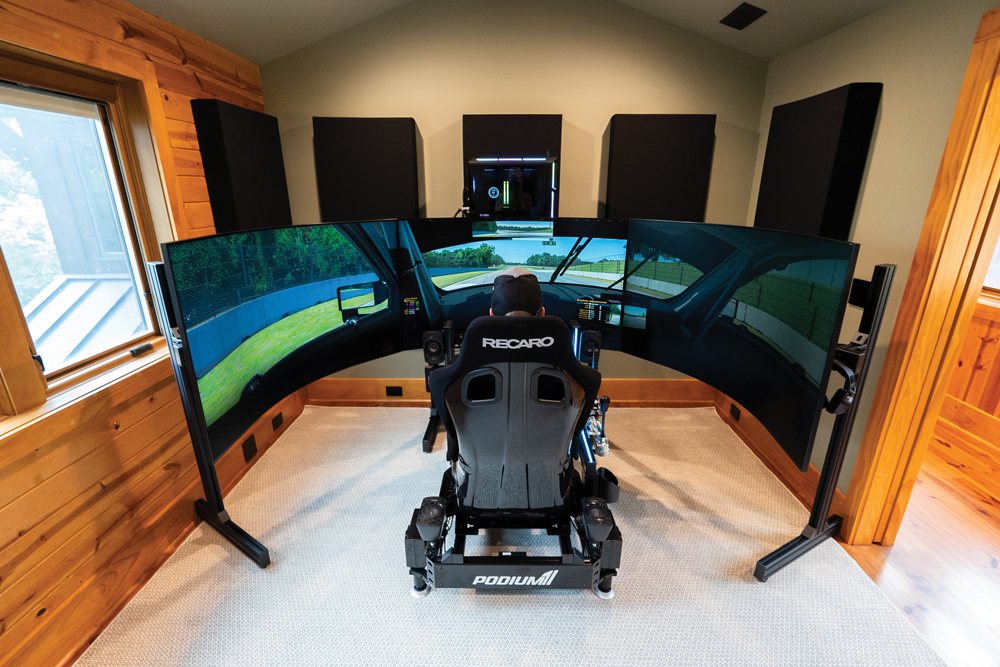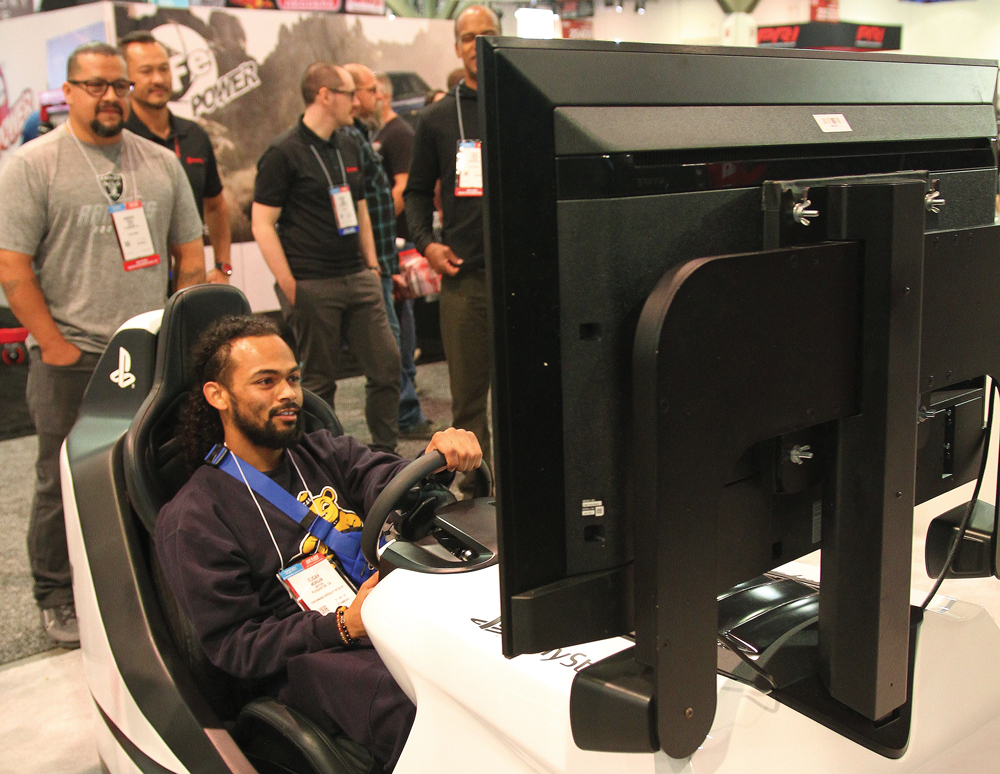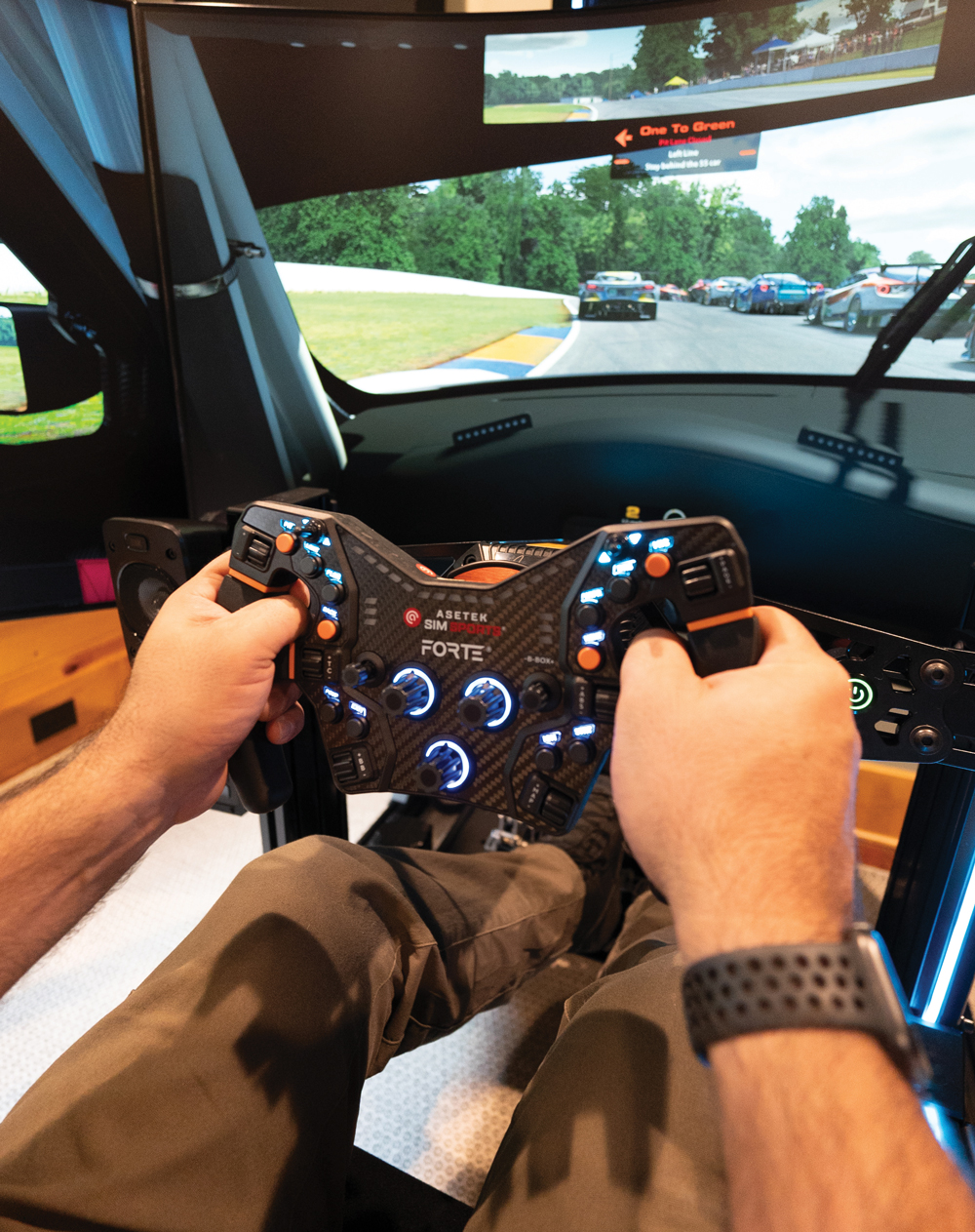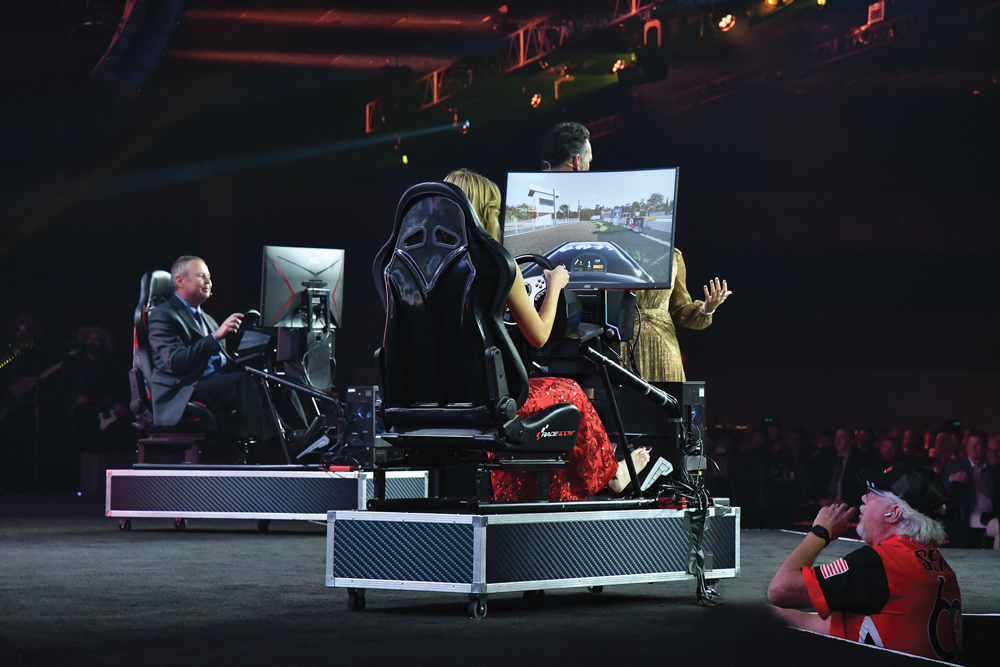SEAT TIME ANY TIME
Once the Exclusive Training Tools of Motorsports Pros, Racing Simulators Are Increasingly Fueling Enthusiast Passions
By Bradley Iger
Once dismissed as mere child’s play, simulators have been an integral part of driver development in top-tier racing series like NASCAR and Formula 1
(F1) for a number of years now. While the systems used at this level of motorsports are often highly customized, multi-million-
dollar setups, the simulation technology that’s now available to the general public is reaching a degree of sophistication that isn’t far behind.
“It’s a lot like the trickle-down effect of F1 race car technology into the production cars that will be on the road a few years down the line,” says Nikolas Dubois of Advanced SimRacing in Anjou, Quebec, Canada. “Use of simulators by racing teams really started to ramp up 15 years ago or so, and now we’re seeing a lot of the technology that they were using at that level being integrated into the gear that people are using in their simulators at home.”
And as Steve Paladino of Podium 1 Racing in Franklin, Tennessee, points out, the combination of increasing sophistication and greater accessibility has yielded a compelling training tool for competitors and driving enthusiasts alike. “People often still write off this technology as just a video game. But what they’re missing is that, at this point, the level of accuracy is part of what makes these simulators fun and immersive. At the end of the day, you have to keep in mind that pro drivers wouldn’t use this stuff if it was garbage. And meanwhile the cost of entry continues to go down, while the quality continues to go up.”
Going Down the Rabbit Hole
Although simulation rigs are more advanced than ever before, there’s still a sizable gap—in terms of both fidelity and cost—between the systems that are commonly used for driver training and the bespoke setups that are created by auto manufacturers and teams in top-tier racing series like F1.
“One of the programs that’s considered a standard in the industry is rFactor,” says Dubois. “There’s a version of this that you can use at home, but top-tier teams and automakers typically use rFactor Pro for engineering development. The Pro version is a very different approach; it’s not what you’d call user-friendly and you have to have engineers to work on the models. Just creating one custom car model in rFactor Pro can cost upwards of a quarter of $1 million. The benefit of that is it takes a huge amount of data into account, so you get a greater level of accuracy from it.” And at this level, the expense of model development is just a fraction of the overall cost involved.

“These are seven-figure setups,” says Robbie Montinola of SRO Motorsports in Austin, Texas. “For the most part, these rigs are built into ‘simulation rooms.’ Think of a room that’s about a 1,000 sq. ft. or so, where they’ve built a very realistic, life-sized version of the race car with the same ergonomics as the car they’re campaigning. So, if it’s a F1 car, it could essentially be an F1 tub with large, curved screens that kind of emulate a 360-degree field of view, and they may be using proprietary simulation
software. They also usually have rooms that are connected to those simulator rooms, where engineers and other support staff are monitoring information and communicating with the driver. Very much a NASA-style experience.”
But for a fraction of that cost, enthusiasts and grassroots competitors can now put together comprehensive home simulator rigs to sharpen their skills, familiarize themselves with course configurations, and experiment with different techniques and car setups.
“I think this shift for software developers got started with the NASCAR computer game that was released back in 2003,” notes Cam Murphy of SimGear Motion Simulators in Schaumburg, Illinois. “Before that game, the majority of what was out there seemed to be mainly focused on entertainment rather than realism, from a physics and driving technique standpoint. That game kind of set a new tone for the at-home user in terms of what was possible, and what could be a relevant training tool for real driving. And more recently, the developers behind racing simulators like iRacing, rFactor and Asseto Corsa have really stepped things up. So much of improving on-track performance is about preparation and fine-tuning things through repetition, and that’s exactly what this allows you to do.”

Many high-end prosumer setups use direct-drive steering wheels, which create realistic feedback from the tires and suspension using internal magnets rather than a traditional gear set. The wheels’ quick-release system also functions much like the ones used in actual race cars, allowing drivers to swap out steering wheels to more closely replicate the vibe of the race car being recreated in the simulator. Multi-display setups are also common, which allow for a greater degree of peripheral vision, while high-end pedal sets can now emulate the brake system feedback that you’d experience in a real race car. Expired racing seats are often used to establish the proper driver positioning in the simulator, too, and some systems have integrated actuators that can shift the entire rig several inches in any direction to replicate the sensations of squat, brake dive and roll, as well as weight-transfer and road-surface variations.
Although the level of realism that this hardware can create is impressive, it can also be costly; an at-home simulator setup that’s put together with a no-expense-spared approach can easily venture into the $50,000 range. But Murphy is quick to point out that many of those advanced features aren’t necessarily required in order to create a useful system, as the software still does a lot of the heavy lifting.
“iRacing is arguably the standard for consumer-level simulators today, and it continues to get better and better. One really important advancement that has become commonplace now is that they started laser-scanning race tracks, and those scans find every nuance in elevation change, and every nook and cranny in the road surface, and that’s translated into the simulation. And, of course, there’s also been a major development effort to accurately replicate real-world physics. That takes into account everything from the weight, weight distribution, and the aerodynamics of the car to the chassis stiffness, suspension setup, tire compounds and pressures, and track conditions.”

Tire modeling has also become an area of intense focus for many software developers as of late. “As an example, with our official racing simulator, Assetto Corsa Competizione, the developers work closely with both the auto manufacturers as well as Pirelli,” Montinola says. “When we change a tire compound in real life, the simulation is updated with new data from Pirelli to reflect that change in the latest tire model. So the tire model is constantly evolving alongside what is happening in real life.”
And as simulator physics continues to move toward parity with reality, telemetry data is becoming an increasingly complementary training tool.
“Virtual Racing School software allows you to record your iRacing telemetry, and within seconds of completing a race, you can go to their site and compare your telemetry data to their pro drivers,” Paladino explains. “So you can immediately see where you’ve done well and where you can find improvement, corner by corner, tenth by tenth.”
Translating Virtual Seat Time, Real-World Results
The headline benefits of using simulators for driver training are fairly straightforward—virtually unlimited track time, minimal costs after the initial investment, and the opportunity to drive tracks you haven’t physically been to yet. But there are also other advantages of simulators that may not be as immediately obvious.
“The reset button is a big one,” Murphy says with a laugh. “But in all seriousness, that gives you the ability to get on a track and go flat-out without risking the expense of wrecking a race car. You can do hours and hours of track time at that pace and not burn an ounce of fuel, go through a single consumable part, or bend a single fender. It not only allows you to get a general idea of where the limits are, it also provides the visual reference points to keep a track configuration fresh in your mind, so when you’re out on track in real life, you can get into that rhythm quicker.”
And the benefits become obvious when drivers who’ve spent time on a simulator then hop behind the wheel of their real vehicles and put that training to work. “When a driver has the opportunity to focus as much time and effort as they want on certain areas where their technique can improve, or where they are leaving time on the table at a certain corner, those efforts definitely become evident when they take what they’ve learned out to the track for real,” says Dubois. “Every time we get a chance to help a client on the simulator, they’re immediately faster in their real car on the next weekend that they’re at the track. People in the paddock will often ask these folks what they did to progress so quickly because the improvements are so noticeable.”
Although racing simulators have come a long way in recent years, it’s important to note that technological limitations remain today. While haptic systems like those made by D-Box can replicate variations in road surfaces and shifts in weight balance, simulators cannot recreate the sustained G-forces created by long, sweeping corners or high-speed braking zones. It may be easy to shrug this off as simply a compromise in the level of immersion that’s available today but, says Montinola, the implications go deeper than entertainment value.
“The overall feel is still a bit different; no matter how good you are in a real car, people tend to be a bit slower in a simulator. And most real race car drivers tend to be slower than the folks who are purely focused on simulator racing. For racers,
I think there’s a degree of disconnection that we still face with simulation technology without those real-world forces communicating information about things like the coefficient of friction. You may know where those limits are in the car, but it’s harder to pinpoint them in the simulator, outside of just looking at the data.”

Still, as this technology becomes increasingly accessible, simulator training is quickly moving beyond the realm of novelty and becoming an obligatory component of teams’ racing programs.
“Leading into each of our race weekends, you’ll see that a large number of our drivers are on social media talking about how they’re training on the simulators,” Montinola adds. “It’s a part of their process now. Practice session track time is limited on race weekends, so they want to get as much training in on the simulator as they can. That way, when they actually get to the track, they’re just dialing in the race car and then they’re ready to
go qualify.”
And the proliferation of simulator technology is just getting started, Paladino says.
“Simulator racing and training has been huge in Europe for a long time, but America is just now waking up to it. Drive to Survive has brought more visibility to it, and the pandemic created a new level of demand for ways for drivers to train at home. And as a result, I think one of the big things we’re going to see is that it’s going to change some of the entry points into motorsports. I think we’re going to see more and more kids getting their start in simulators who end up being very competitive in the real world. And I think it’s going to help lower the barrier for talented drivers that might not have the opportunity otherwise.”
Dubois says that as the technology becomes more accessible while also becoming more advanced in terms of accuracy and depth, its use as training tool by may eventually become ubiquitous.
“Simulation has come a long way in recent years, but it’s still in its infancy right now, and I think it’s going to be much more mainstream in the near future. Eventually it’s going to be almost mandatory to have a simulator at home for anyone who drives competitively. And that’s because, if you don’t, you’re never going to be as prepared as someone who can train for hours and hours a day if they want to. It’s all about practice.”






